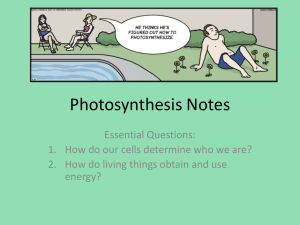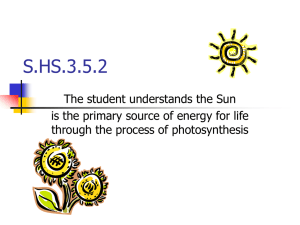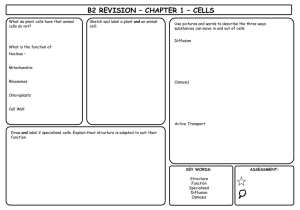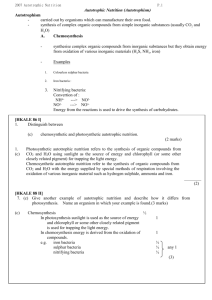Photosynthesis
advertisement
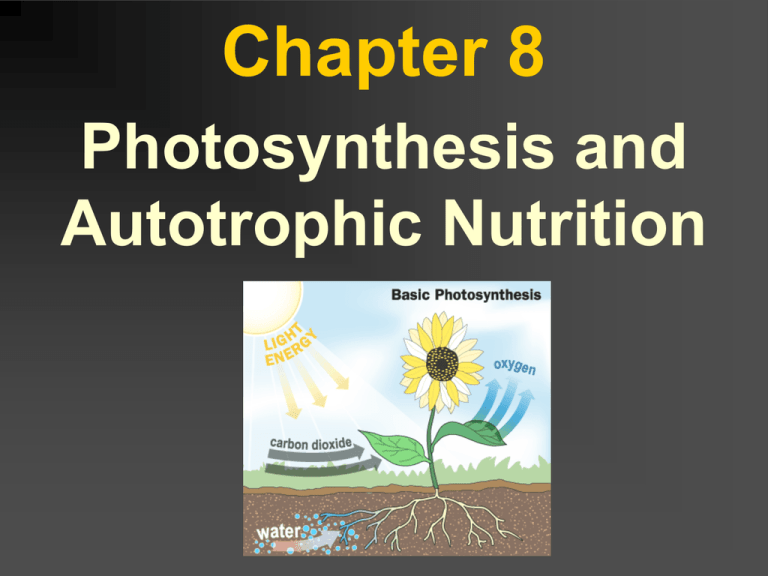
Chapter 8 Photosynthesis and Autotrophic Nutrition Nutrition The activities by which an organism obtains, processes, and uses food to carry on their life functions Two Types of Nutrition 1. Heterotrophic Nutrition 2. Autotrophic Nutrition (I) Autotrophic Nutrition A type of nutrition in which an organism can make its own food Ex: green plants algae some bacteria Autotroph An organism capable of making their own food Photosynthesis The most common type of autotrophic nutrition In this process, organisms use energy from sunlight, carbon dioxide, and water to make its own food Chloroplast Contains a green pigment called chlorophyll It is in the chloroplast that light energy is trapped by chlorophyll and glucose is formed as the product (food) Structure of Chloroplast Formula for Photosynthesis 6 CO2 + 12 H20 C6H12O6 + 6 H20 + 6 02 ROY G BIV Light is composed of many different wavelengths Why does something like the apple below look green? Pigments A pigment is a substance that absorbs certain wavelengths of light while others get reflected Chlorophyll, carotene and xanthophyll are pigments found in plants Pigments (molecules) can be separated using a process called chromatography Below show how a spectrophotometer works. A certain wavelength of light passes through a small opening. The light then passes through a solution. The amount of light that gets absorbed is then measured. If all the wavelengths are passed through the solution, an absorption spectrum is produced. Above is a picture of a real spectrophotometer. Below is the absorption spectrum for chlorophyll. What colors does chlorophyll (in plants) absorb for use during photosynthesis? Light Absorbed by Chlorophyll The maximum amount of photosynthesis will occur when exposed to red and blue light because it is these two colors that are easily absorbed in great quantity by the chlorophyll Photosynthesis occurs in two stages: 1.Light (Photochemical) Reaction: Also known as the Light-Dependent Reaction 2. Dark (Carbon Fixation) Reaction: Aka. The LightIndependent Reaction 1. Light Reaction (Photochemical Reactions) 1. 2. 3. 4. Occurs in the grana of the chloroplast First stage of photosynthesis Begins with the absorption of light energy by chlorophyll Photolysis occurs- a reaction in which H2O molecules split into oxygen and hydrogen Light Reactions (Cont.) 5. 6. 7. 8. All oxygen given off during photosynthesis comes from the photolysis of water ATP (Adenosine triphosphate), which is a form of energy, is produced Hydrogen (H) is picked up by the hydrogen acceptor NADP. When NADP accepts the hydrogen, it gets reduced to NADPH The ATP and NADPH are used in the carbon fixation reactions Light Reaction 2. Carbon Fixation Reaction Occurs in the stroma of the chloroplast The second stage of photosynthesis It is here that CO2 is converted to carbohydrates by a process called carbon fixation Light is not required The light-independent reaction requires ATP to take place Dark Reaction Detailed look at Carbon Fixation What two products from the photochemical reactions are used during the carbon fixation reactions? ATP and NADPH Chemiosmosis in Photosynthesis ATP is produced as the H+ pass through the enzyme ATP synthase Show video clip – Light dependent reactions: Part 2 Factors Affecting the Rate of Photosynthesis 1. 2. 3. 4. Light Intensity Water Carbon dioxide level Temperature Adaptations for Photosynthesis A. Unicellular Organisms 1. Almost all chlorophyll-containing unicellular organisms are aquatic (live in water) 2. The raw materials for photosynthesis are absorbed directly from the water and into the cell Ex: algae B. Terrestrial Plants (land-dwelling) 1. Occurs in leaves that provide the maximum surface area for the absorption of light Cross-section of a Leaf Cross section of Leaf 1. 2. Outer most layer is the epidermis which is covered by a waxy coat called the cuticle – which prevents excess water loss Stomates- allows the exchange of O2 and CO2 between the leaf and the external environment 3. 4. 5. Guard cells- control the opening and closing of the stomates Palisade Layer- is where most of photosynthesis takes place Vein- contain xylem and phloem (known as vascular tissue) Chemosynthesis A type of autotrophic nutrition Does not require light as an energy source Energy is obtained by chemical reactions within the cell Nutrients and Enzyme Review Carbohydrates main source of energy for cell activities glucose molecules are the building blocks of carbohydrates Lipids commonly known as fats source of stored energy in living organisms The building blocks for lipids are 3 fatty acids and 1 glycerol molecule Proteins along with lipids, protein molecules make up part of the cell membrane amino acids are the building blocks of proteins Dehydration Synthesis vs. Hydrolysis Dehydration Synthesis the process in which two molecules are joined together, with the help of enzymes, to form a larger molecule plus water Ex: glucose + glucose = maltose + water Hydrolysis is the opposite of dehydration synthesis hydrolysis is the process in which large molecules are broken down into smaller ones by the addition of water and enzymes Ex: maltose + water = glucose + glucose Enzymes Are known as a catalyst All enzymes end in ase Ex: substrate enzyme maltose maltase lipid lipase Enzymes regulate the rate at which reactions occur Lock-and-Key Model substrate- material to which the enzyme attaches to (see diagram) only certain enzymes can break down certain substrates after the enzyme attaches to the substrate, an enzyme-substrate complex is formed the substrate is then broken down into smaller molecules Factors that Influence Enzyme Action Temperature- as you increase temperature, enzyme action will increase until an opitmum temperature of 37 degrees Celsius is reached Enzyme-Substrate Concentration1. High levels of enzyme + low levels of substrate = an increase in enzyme action 2. Low levels of enzyme + high levels of substrate = a decrease in enzyme action pH- affects enzyme action. Some enzymes work better in an acidic environment compared to a basic environment



